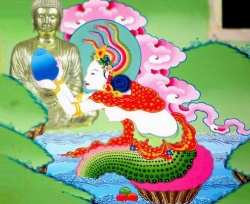Difference between revisions of "Nine mountains and eight seas"
| Line 1: | Line 1: | ||
[[File:100fd159 n.jpg|thumb|250px|]] | [[File:100fd159 n.jpg|thumb|250px|]] | ||
| + | |||
| + | |||
| + | |||
| + | |||
| + | |||
| + | |||
| + | |||
| + | |||
| + | |||
| + | |||
<poem> | <poem> | ||
[[nine mountains and eight seas]] | [[nine mountains and eight seas]] | ||
[[九山八海]] (Jpn [[kusen-hakkai]] ) | [[九山八海]] (Jpn [[kusen-hakkai]] ) | ||
| − | The [[mountains]] and seas that constitute the [[world]], according to {{Wiki|ancient Indian}} [[cosmology]]. The nine [[mountains]] are [[Mount Sumeru]] at the center of the [[world]] and eight concentric mountain ranges that surround it. Eight concentric seas separate these mountain ranges. According to The [[Dharma Analysis Treasury]], the eight circular mountain ranges are, from the inner-most out, | + | The [[mountains]] and seas that constitute the [[world]], according to {{Wiki|ancient Indian}} [[cosmology]]. The nine [[mountains]] are [[Mount Sumeru]] at the center of the [[world]] and [[eight concentric mountain ranges]] that surround it. [[Eight concentric seas]] separate these {{Wiki|mountain ranges}}. According to The [[Dharma Analysis Treasury]], the eight circular {{Wiki|mountain ranges}} are, from the inner-most out, |
[[Yugamdhara]], | [[Yugamdhara]], | ||
| Line 15: | Line 25: | ||
[[Chakravada-parvata]]. | [[Chakravada-parvata]]. | ||
| − | All these mountain ranges are made of {{Wiki|gold}} except the outermost, [[Chakravada-parvata]], also known as the [[Iron Encircling Mountains]], which is made of {{Wiki|iron}}. [[Mount Sumeru]] and the eight mountain ranges are each separated from one another by a sea. The distance between [[Mount Sumeru]] and [[Mount Yugamdhara]] is eighty thousand [[yojanas]]. The inner seven seas are of fresh [[water]], while the outermost sea, just inside the {{Wiki|iron}} mountain range, is [[salty]]. In this sea are [[four continents]]—[[Purvavideha]] in the [[east]], [[Jambudvipa]] in the [[south]], [[Aparagodaniya]] in the [[west]], and [[Uttarakuru]] in the [[north]]. | + | All these {{Wiki|mountain ranges}} are made of {{Wiki|gold}} except the outermost, [[Chakravada-parvata]], also known as the [[Iron Encircling Mountains]], which is made of {{Wiki|iron}}. [[Mount Sumeru]] and the [[eight mountain ranges]] are each separated from one another by a sea. The distance between [[Mount Sumeru]] and [[Mount Yugamdhara]] is eighty thousand [[yojanas]]. The inner seven seas are of fresh [[water]], while the outermost sea, just inside the {{Wiki|iron}} mountain range, is [[salty]]. In this sea are [[four continents]]—[[Purvavideha]] in the [[east]], [[Jambudvipa]] in the [[south]], [[Aparagodaniya]] in the [[west]], and [[Uttarakuru]] in the [[north]]. |
See also[ [[four continents]]. | See also[ [[four continents]]. | ||
Latest revision as of 05:26, 2 April 2024
nine mountains and eight seas
九山八海 (Jpn kusen-hakkai )
The mountains and seas that constitute the world, according to ancient Indian cosmology. The nine mountains are Mount Sumeru at the center of the world and eight concentric mountain ranges that surround it. Eight concentric seas separate these mountain ranges. According to The Dharma Analysis Treasury, the eight circular mountain ranges are, from the inner-most out,
Yugamdhara,
Ishadhara,
Khadiraka,
Sudarshana,
Ashvakarna,
Vinataka,
Nimimdhara, and
Chakravada-parvata.
All these mountain ranges are made of gold except the outermost, Chakravada-parvata, also known as the Iron Encircling Mountains, which is made of iron. Mount Sumeru and the eight mountain ranges are each separated from one another by a sea. The distance between Mount Sumeru and Mount Yugamdhara is eighty thousand yojanas. The inner seven seas are of fresh water, while the outermost sea, just inside the iron mountain range, is salty. In this sea are four continents—Purvavideha in the east, Jambudvipa in the south, Aparagodaniya in the west, and Uttarakuru in the north.
See also[ four continents.
